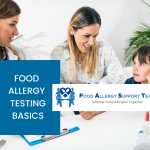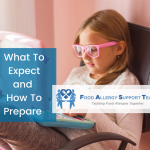When OIT Is Not Needed For Peanut and Tree Nut Allergy

A 10-year-old male came to see me about the possibility of starting oral immunotherapy. He has an older sister who has had a life-threatening peanut reaction, followed by lifelong high positive skin and blood tests for peanuts. The patient’s mom became an expert at peanut and tree nut avoidance in the home, so the younger brother had never eaten them. By screening at age 3 he had positive skin tests for peanut and hazelnut. By that age, this young man also required treatment for persistent asthma. When I met them, he was taking 2 daily medications for asthma, but every spring he had poor control and needed an oral steroid. That’s when I looked at the peanut and tree nut testing again with component panels.
Not surprisingly, he had very high Ara h8 and hazelnut Cor a1 while he was notably negative to Ara h1, 2, 3, 6, and 9 as well as Cor a 9 and 14. Ara h8 and Cor a1 are relatively low-risk proteins that are analogs of Bet v1, which is associated with birch pollen allergy. This profile on the component testing strongly suggests that my patient does not have a true peanut or hazelnut allergy, but rather has “oral allergy syndrome”, which is really a function of certain pollen allergies (in this case, birch pollen). On further questioning, he endorsed an itchy mouth while eating some fresh apples and carrots. This clinical history, in conjunction with the component profiles for peanut and hazelnut, is diagnostic of an oral allergy syndrome.
As his asthma and rhinitis were not controlled in the spring, I first elected to improve that, eventually starting him on subcutaneous high-dose tree pollen immunotherapy (allergy shots). About 2 years later, after maintenance shots for at least a year, his asthma was well controlled and we started lessening his daily asthma medications. We then looked at his nut testing again, which although decreased, still strongly lined up with a food and pollen cross-reactivity pattern.
He challenged successfully each of the avoided nuts and is now able to consume both peanut and hazelnut with no difficulty. It’s likely that had we challenged him to the nuts before the tree pollen immunotherapy, he may have had reactions similar to those experienced with fresh apple and carrot (mild itchy mouth or throat) but oral allergy syndrome would be extremely unlikely to ever cause anaphylaxis. The fact that he passed the peanut and hazelnut challenges with no symptoms reflects his body’s desensitization to birch pollen, which is causing the molecular cross-talk that results in birch-pollen OAS. Of note, he no longer reports any symptoms with apple or carrot, either, since that operates via the same cross-reactive mechanism.
This case reminds us all that for patients that have never eaten a nut to which they have a positive blood or skin test, sometimes it is not the nut itself that is causing the problem. Food component testing followed by a supervised oral food challenge when indicated are important tools to help us understand the true nature of the apparent food allergy.
Meanwhile, I remain ready to offer peanut oral immunotherapy for his sister when she is ready!
*****************
UBMD Pediatrics/ Allergy , Immunology & Rheumatology – Buffalo




